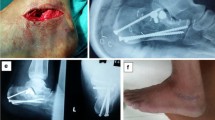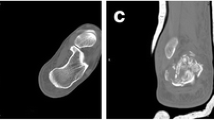Abstract
Objective
A minimally invasive technique to prevent soft tissue problems using a calcaneal nail (Calcanail®, FH Orthopedics, Heimsbrunn, France) for calcaneal fractures or in subtalar joint arthrodesis is described.
Indications
Displaced extra-articular calcaneal fractures involving the tuberosity fragment and in displaced intra-articular calcaneal fractures with impression and/or displacement of the subtalar joint surface. Subtalar joint arthrodesis for posttraumatic subtalar osteoarthritis.
Contraindications
Severely displaced fractures type Sanders IV with the purpose of internal fixation; peripheral calcaneal fractures; general contraindications for operative treatment.
Surgical technique
Minimally invasive reduction of calcaneal fractures using a special distractor and a graft pusher through a calcaneal working channel. Fixation performed via the insertion of the Calcanail® and the two locking screws, optional additional screws. Subtalar joint arthrodesis with a Calcanail® used with optional three locking screws to fix the talus and calcaneus creating an angular stable construct.
Postoperative management
Mobilization and restricted weight-bearing for 6 weeks in the patient’s own shoes after fracture fixation or in a walker after arthrodesis.
Results
Preliminary results of 69 cases from three surgical centers have already been published. From 2013–2017, the technique was used in 48 of our own patients (42 calcaneal fracture reduction and fixation; 6 for subtalar joint arthrodesis). Mean postoperative hospital stay was 7 days for fracture reduction without any need of additional operations. During follow-up, 6 implant removals and 2 secondary subtalar fusions were noticed. All 6 cases of subtalar joint arthrodesis were planned in posttraumatic subtalar osteoarthritis.
Zusammenfassung
Operationsziel
Beschreibung einer minimal-invasiven Technik zur Verhinderung von Weichteilschäden mit einem Kalkaneusverriegelungsnagel (Calcanail®) bei Osteosynthese von Kalkaneusfrakturen oder subtalarer Arthrodese.
Indikationen
Dislozierte extraartikuläre Kalkaneusfrakturen unter Einbeziehung des calcaneal tuberosity, dislozierte Gelenkfrakturen des Kalkaneus mit imprimierter/dislozierter subtalarer Gelenkfläche, posttraumatische subtalare Arthrose durch Arthrodese des unteren Sprunggelenks.
Kontraindikationen
Schwer dislozierte Kalkaneusfrakturen Typ Sanders IV mit dem Ziel der Frakturosteosynthese, periphere Kalkaneusfrakturen, generelle Operationskontraindikationen.
Operationstechnik
Innere Reposition von Kalkaneusfrakturen in minimal-invasiver Technik mit speziellem Distraktor und Knochenstößel über einen kalkanearen Arbeitskanal. Osteosynthetische Stabilisierung durch den eingebrachten Calcanail® und 2 Verriegelungsschrauben, ggf. zusätzliche Kleinfragmentschrauben. Bei subtalarer Arthrodese wird der Calcanail® mit optional 3 Verriegelungsschrauben eingesetzt, um Talus und Kalkaneus winkelstabil miteinander zu fixieren.
Weiterbehandlung
Mobilisation unter Teilbelastung für 6 Wochen im patienteneigenen Schuh nach Frakturversorgung und im Walker nach Arthrodese.
Ergebnisse
Vorläufige Ergebnisse von 69 Fällen nach Kalkaneusfraktur aus drei operativen Zentren wurden publiziert. Im eigenen Patientengut wurde der Calcanail® von 2013–2017 in 48 Fällen eingesetzt (42 zur Frakturosteosynthese bei Kalkaneusfrakturen, 6 zur subtalaren Arthrodese). In der Osteosynthesegruppe betrug die mittlere postoperative Krankenhausverweildauer 7 Tage ohne Notwendigkeit zusätzlicher Operationen. Während der Nachbehandlung wurden 6 Implantate entfernt und 2 sekundäre subtalare Arthrodesen beobachtet. Alle 6 Fälle der subtalaren Arthrodesen wurden bei posttraumatischer subtalarer Arthrose geplant.



























Similar content being viewed by others
References
Abidi NA, Dhawan S, Gruen GS et al (1998) Wound-healing risk factors after open reduction and internal fixation of calcaneal fractures. Foot Ankle Int 19:856–861
Battaglia A, Catania P, Gumina S, Carbone S (2015) Early minimally invasive percutaneous fixation of displaced intra-articular calcaneal fractures with a percutaneous angle stable device. J Foot Ankle Surg 54(1):51–56
Buckley R, Leighton R, Sanders D, Poon J, Coles CP, Stephen D, Paolucci EO (2014) Open reduction and internal fixation compared with ORIF and primary subtalar arthrodesis for treatment of Sanders type IV calcaneal fractures: a randomized multicenter trial. J Orthop Trauma 28(10):577–583
Encke A, Haas S, Kopp I et al. (2015) S3-Leitlinie Prophylaxe der venösen Thromboembolie (VTE). https://www.awmf.org/leitlinien/detail/II/003-001.html. Accessed on 12/12/2017
Falis M, Pyszel K (2016) Treatment of displaced intra-articular calcaneal fractures by intramedullary nail. Preliminary report. Ortop Traumatol Rehabil 18(2):141–147
Gallie WE (1943) Subastragalar arthrodesis in fractures of the os calcis. J Bone Joint Surg 25:731–736
Goldzak M, Mittlmeier T, Simon P (2012) Locked nailing for the treatment of displaced articular fractures of the calcaneus: description of a new procedure with calcanail®. Eur J Orthop Surg Traumatol 22:345–349
Goldzak M, Simon P, Mittlmeier T, Chaussemier M, Chiergatti R (2014) Primary stability of an intramedullary calcaneal nail and an angular stable calcaneal plate in a biomechanical testing model of intraarticular calcaneal fracture. Injury 45(Suppl 1):49–53
Howard JL, Buckley R, McCormack R, Pate G, Leighton R, Petrie D, Galpin R (2003) Complications following management of displaced intra-articular calcaneal fractures: a prospective randomized trial comparing open reduction internal fixation with nonoperative management. J Orthop Trauma 17:241–249
Hüfner T, Geerling J, Gerich T, Zeichen J, Richter M, Krettek C (2007) Open reduction and internal fixation by primary subtalar arthrodesis for intraarticular calcaneal fractures. Oper Orthop Traumatol 19:155–169
Pompach M, Carda M, Amlang M, Zwipp H (2016) Versorgung des Fersenbeinbruchs mit einem Verriegelungsnagel (C-Nail). Oper Orthop Traumatol 28:218–230
Rammelt S, Amlang M, Barthel S, Gavlik JM, Zwipp H (2010) Percutaneous treatment of less severe intraarticular calcaneal fractures. Clin Orthop Relat Res 468:983–990
Reinhardt S, Martin H, Ulmar B, Döbele S, Zwipp H, Rammelt S, Richter M, Pompach M, Mittlmeier T (2016) Interlocking nailing versus interlocking plating in intraarticular calcaneal fractures: a biomechanical study. Foot Ankle Int 37(8):891–897
Simon P, Goldzak M, Eschler A, Mittlmeier T (2015) Reduction an internal fixation of displaced intra-articular calcaneal fractures with a locking nail: a prospective study of sixty nine cases. Int Orthop 39:2061–2067
Van Hoeve S, Poeze M (2016) Outcome of minimally invasive open and percutaneous techniques for repair of calcaneal fractures: a systematic review. J Foot Ankle Surg 55(6):1256–1263
Zwipp H, Pasa L, Zilka L, Amlang M, Rammelt S, Pompach M (2016) Introduction of a new locking nail for treatment of intraarticular calcaneal fractures. J Orthop Trauma 30(3):88–92
Author information
Authors and Affiliations
Corresponding author
Ethics declarations
Conflict of interest
T. Mittlemeier shares the patent on the Calcanail® implant. R. Rotter has received a speaker honorarium from FH Orthopedics. M. Saß declares that he has no competing interests.
This article does not contain any studies with human participants or animals performed by any of the authors.
Additional information
Editor
S. Rammelt, Dresden
Illustrator
R. Himmelhan, Mannheim
Rights and permissions
About this article
Cite this article
Saß, M., Rotter, R. & Mittlmeier, T. Minimally invasive internal fixation of calcaneal fractures or subtalar joint arthrodesis using the Calcanail®. Oper Orthop Traumatol 31, 149–164 (2019). https://doi.org/10.1007/s00064-018-0576-2
Received:
Revised:
Accepted:
Published:
Issue Date:
DOI: https://doi.org/10.1007/s00064-018-0576-2
Keywords
- Calcaneus
- Fracture reduction and fixation
- Osteoarthritis
- Minimally invasive surgical procedures
- Foot joints




